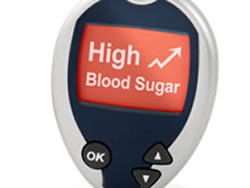Difference between Diabetes and High Blood Sugar
Key difference: High Blood Sugar is a condition that at times may affect some people. The blood sugar concentration or blood glucose level is the amount of glucose (sugar) that is present in the blood. If the blood sugar levels are often outside the normal range, it may be an indicator of a medical condition, such as Diabetes. Diabetes is a type of disease that affects people with high blood sugar.
 High Blood Sugar is a condition that at times may affect some people. The blood sugar concentration or blood glucose level is the amount of glucose (sugar) that is present in the blood. The glucose is transported from the intestines or liver to body cells via the bloodstream. Here, a hormone makes the glucose available for cell absorption. The hormone is called insulin and is produced primarily in the pancreas.
High Blood Sugar is a condition that at times may affect some people. The blood sugar concentration or blood glucose level is the amount of glucose (sugar) that is present in the blood. The glucose is transported from the intestines or liver to body cells via the bloodstream. Here, a hormone makes the glucose available for cell absorption. The hormone is called insulin and is produced primarily in the pancreas.
The reason for high blood sugar is that either there isn’t enough insulin in the body or that the cells do not react as expected to the insulin. Both cases result in the cells not absorbing the glucose, hence increased levels of glucose in the bloodstream.
According to Wikipedia, the recommended level of normal blood glucose level in humans is about 5.5 mM (5.5 mmol/L or 100 mg/dL, i.e. milligrams/deciliter). However, the level fluctuates throughout the day, depending on the time and amount of food intake. Glucose levels are usually lowest in the morning, before the first meal of the day and rise after meals for an hour or two by a few millimolar.
Wikipedia states that the normal blood glucose level while fasting (i.e. before the first meal of the day (for non-diabetics, should be between 70 and 100 milligrams per deciliter (mg/dL). While, the blood sugar levels for those without diabetes and who are not fasting should be below 125 mg/dL.
It is the body’s task to naturally maintain the glucose level as a part of metabolic homeostasis. However, at times the body may not be able to tightly regulate the blood glucose levels. If the blood sugar levels are often outside the normal range, it may be an indicator of a medical condition, such as Diabetes.
 Diabetes is a type of disease that affects people with high blood sugar. There may be two main reasons for diabetes; either that the pancreas is not producing enough insulin to as to counter the amount of glucose in the bloodstream or that the cells are not responding to the insulin that is produced. The high blood sugar levels correspond to classical symptoms of frequent urination, increased thirst and increased hunger.
Diabetes is a type of disease that affects people with high blood sugar. There may be two main reasons for diabetes; either that the pancreas is not producing enough insulin to as to counter the amount of glucose in the bloodstream or that the cells are not responding to the insulin that is produced. The high blood sugar levels correspond to classical symptoms of frequent urination, increased thirst and increased hunger.
There are three main types of diabetes:
- Type 1 Diabetes – This relates to the body's failure to produce insulin. It requires the person to inject insulin or wear an insulin pump. Also known as "juvenile diabetes".
- Type 2 Diabetes – This results from insulin resistance, in which cells fail to use insulin properly or are resistant to insulin. Also known as "adult-onset diabetes".
- Gestational Diabetes – This occurs when pregnant women without a previous diagnosis of diabetes develop a high blood glucose level. It may precede development of type 2 DM.
Some other forms of diabetes include congenital diabetes, which is due to genetic defects of insulin secretion, cystic fibrosis-related diabetes, steroid diabetes induced by high doses of glucocorticoids, and several forms of monogenic diabetes.
As per the American Diabetes Association, the blood glucose target range for diabetics should be 70–130 (mg/dL) before meals, and less than 180 mg/dL after meals.
Image Courtesy: diabetes.co.uk, dhs.wisconsin.gov









Add new comment